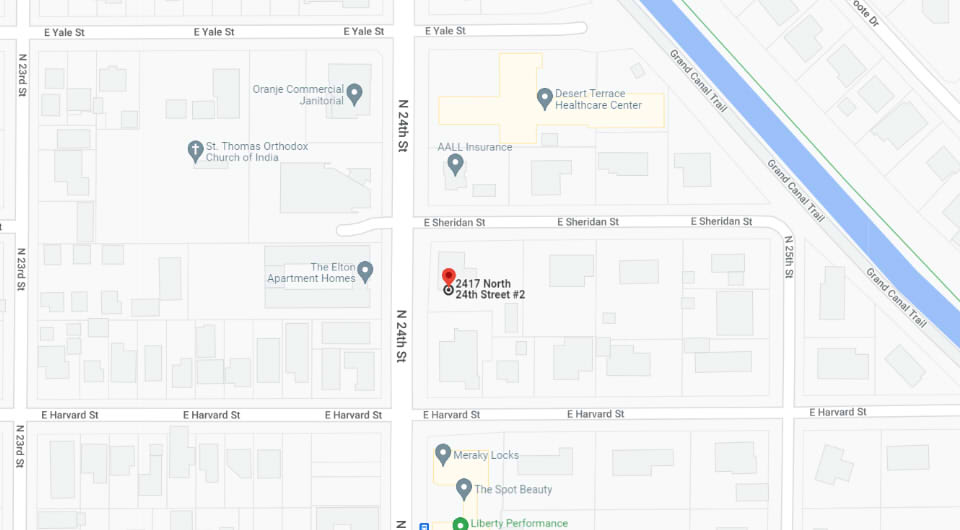Anesthesia is a medical procedure in which anesthetics are used to numb specific parts of your body. This practice is common in surgical and other invasive medical procedures to protect patients from pain. Various medical professionals, including anesthesiologists, dentists, doctors, and nurses, can administer anesthesia. Some operations necessitate the assistance of an anesthesiologist who is fully trained in anesthesia administration. Anesthesia must be administered with caution because it can be dangerous. Even today, despite medical advancements, mistakes occur. Complications can occur for various reasons, including insufficient or excessive anesthesia or incorrect anesthetic use.
Anesthesia errors are considered medical malpractice. The liable party can be held responsible for the resulting damages. As a result, if you or someone you care about has sustained injuries due to an anesthesia error in Phoenix, you can file a lawsuit against the responsible party. Do not hesitate to contact our skilled personal injury attorneys at Phoenix Personal Injury Attorney Law Firm for legal assistance and advice.
Types of Anesthesia
Every year, millions of surgical procedures are performed in the United States. With such a high number, it is incredibly fortunate that medical technology has made anesthesia administration simple and safe. But even with modern technology, anesthesia errors still occur. When they do, the consequences are disastrous. Some patients sustain permanent injuries, while others die.
If an anesthesia error causes an injury or death, you could seek compensation through a medical malpractice lawsuit against the responsible party. However, not all medical errors constitute medical malpractice. That is why you should consult an experienced personal injury attorney to determine the best way to handle your situation. But first, it is essential to understand the various types of anesthesia used in today's hospitals and why they are necessary.
Remember that anesthesia can help you avoid pain and discomfort during surgical and other invasive medical procedures. Various types of anesthesia have been used in the medical field for many years. Today, there are three main types of anesthesia:
Local Anesthesia
Doctors use local anesthesia to numb a specific body part that requires treatment. This type of anesthesia is typically used for less invasive medical procedures like biopsy or mole removal. It sends signals to the brain and stops the nerves in the treatment area. You do not feel pain after taking it, but you can feel movement or pressure. It takes a few minutes after receiving local anesthesia to lose feeling in that area. Your body will regain full sensation when the medicine wears off, possibly after a few hours.
Regional Anesthesia
It is a type of pain relief used by doctors to numb a large portion of your body. For example, regional anesthesia is necessary to numb the lower half of your body. The anesthesiologist could administer the medicine via a small tube (catheter) or injection. Doctors can use general anesthesia when local anesthesia is insufficient for the type of treatment required. It is also the preferred anesthesia when the medical treatment requires the patient to remain awake throughout the procedure.
General Anesthesia
A combination of medications puts you to sleep before a medical procedure. Because you are entirely unconscious after receiving general anesthesia, you do not feel pain. Though the drug appears to put you to sleep, general anesthesia does much more. Your brain ignores pain signals and reflexes.
General anesthesia is necessary for medical procedures that:
- Take a long time.
- Expose your body to a cold environment.
- Result in massive blood loss, or
- Those that affect your breathing.
In most hospitals, anesthesia is administered by a team of specially trained professionals or a single professional. The administrator stays with you throughout the procedure to keep an eye on you. However, anesthesiologists, nurses, doctors, and other medical personnel caring for you during the process can make mistakes. If the team does not communicate effectively, or one of the team members makes a mistake, an error can occur, with disastrous consequences. When this happens, it is best to seek legal counsel to determine what steps you can take to recover your losses.
Possible Injuries and Complications Due to Anesthesia Errors
Anesthesia administration errors could result in the following injuries and complications:
- Vomiting and nausea.
- Post-operative discomfort and pain.
- Teeth damage from improper intubation or insertion of a breathing tube during the surgical procedure.
- Delirium/temporary confusion.
- Nerve damage.
- The heart attack.
- Stroke.
- Laryngeal injury and/or sore throat.
- Anaphylaxis, or severe allergic reactions to the medication.
- Pneumonia.
- Difficulties with breathing.
- Clots in the blood.
- Brain damage caused by insufficient oxygen during surgery.
- Anesthesia awareness, a condition in which you regain consciousness during a surgical procedure.
- Death.
The potential consequences of anesthesia errors are lengthy, and the majority are severe. Minor complications like nausea, vomiting, and postoperative pain are common, but severe complications are extremely uncommon. When the latter occurs, it is important to work with an attorney to establish whether you qualify for compensation under the personal injury laws.
Serious Errors When Administering Anesthesia
Some errors can occur during anesthesia administration. The following are the most common mistakes:
- Administering anesthesia at the incorrect dosage — The anesthesiologist can administer too little or too much medication.
- Improper patient intubation can result in tooth damage — This is the most common anesthesia error and the leading cause of anesthesiologist malpractice lawsuits.
- Failure to properly monitor patients after anesthesia administration.
- Failure to detect emerging complications.
- Turning the pulse monitor alarm off, either intentionally or unintentionally — The alarm measures oxygen levels in a patient's blood. It is impossible to know when the patient's oxygen levels fall when it is turned off.
- Failure to keep track of oxygen delivery to a patient's blood — The anesthesiologist cannot tell when the patient is not getting enough oxygen.
- Failure to prepare a patient before anesthesia administration — Patients should be informed that they should not eat or drink anything for a given period before the medical procedure.
Additionally, the anesthesiologist must ensure that you are moved regularly during the procedure to avoid putting additional pressure on one or more parts of your body. While this is not an anesthesia error, it can result in medical malpractice. If you do not move around during a medical procedure and put more pressure on one part of your body, you could injure your optic nerve and go blind.
In most cases, what the anesthesiologist, nurse, doctor, or any other medical professional working with you during a medical procedure does or fails to do can constitute medical malpractice if it results in injuries or death.
Proving Negligence After an Anesthesia Error
Medical malpractice can take many forms, the primary cause being medical negligence by one or more healthcare providers. For example, if an anesthesia error by the anesthesiologist caused your injuries, the anesthesiologist would be the negligent party. However, if the medical team in charge of your operation made multiple mistakes that resulted in your injuries or the death of a loved one, they will be held liable for medical negligence.
In general, negligence occurs when one or more parties fail to use reasonable care when handling you or if they do something incorrectly. The criminal justice system defines negligence in cases involving medical malpractice as a failure by a medical practitioner to exercise the level of skill and care of an average healthcare provider practicing the same specialty as the provider, considering the provider's advancement in their profession and the resources at the provider’s exposure.
If your anesthesiologist, doctor, nurse, or anyone else involved in your care breached their duty of care and you sustained injuries, you must prove their negligence in court. It is the only way the court will award your damages. Proving negligence is an essential step in recovering damages following a personal injury. As a result, you will require legal assistance to prepare and file a successful claim in civil court against the responsible party.
A personal injury lawyer can assist you in various ways, including advising you on your options, defending your rights, and gathering sufficient evidence to support your claim. They can also hire expert medical witnesses to assist you, and the judge understands what occurred.
For example, they can review your pre- and post-surgical risk factors and the operative notes of the team members involved. They will also consider the complication rate of the anesthesia you received during the procedure.
With the proper evidence and the assistance of an attorney, you can file a claim against the negligent party. The defendant could be willing to settle the matter out of court to avoid lengthy and costly court processes. Your attorney will negotiate a favorable settlement on your behalf. However, if the payment is not close to what you truly deserve for your damages, you can file a civil lawsuit.
Who Could Be Liable in Your Lawsuit?
Medical malpractice cases are notoriously difficult to prove. It would be best if you collaborated with someone who understands how anesthesia works, potential errors, and the responsible party’s role in causing your injury. Several parties, including the following, could be held liable for your injuries:
The Hospital
When filing a medical malpractice claim, you must first establish the hospital's role in causing your injury. A hospital can be liable for your damages following an anesthesia error if:
- The anesthesiologist, nurse, doctor, or medical practitioner who made the mistake that resulted in your injury is a hospital employee. Vicarious liability holds hospitals liable for negligent acts of their employees.
- If the person who caused your injury was an independent contractor working for the hospital at the time. The hospital is in charge of hiring and supervising independent contractors.
- If the error was caused by equipment failure. A hospital is responsible for repairing and maintaining its equipment. If equipment fails and you are injured, the hospital is at fault for failing to keep its equipment in proper working condition.
The Anesthesiologist
Hospitals are generally not liable for negligent acts of anesthesiologists who participate in medical procedures but are not hospital employees. If an anesthesiologist working as an independent contractor were negligent in causing your injuries, they would be held liable. Independent contractors are only called in when a specific medical procedure requires them. Because they are not hospital employees, hospitals are not, to some extent, responsible for their negligent actions.
To file a lawsuit against a negligent anesthesiologist, you must first determine whether they are a hospital employee or an independent contractor. This is a complicated legal matter because it involves reviewing the anesthesiologist's and the hospital's employment contracts and if the hospital controls the anesthesiologist's performance and working conditions.
In general, if the hospital has more control over an independent contractor's dealings, including their performance, the court will likely find the contractor to be an employee of the hospital. You will then file a lawsuit against the hospital. However, if the anesthesiologist worked independently, they would be named defendants in your case.
Given the complexities of establishing liability in a medical malpractice case, it is best to hire an experienced personal injury lawyer from the beginning of the legal process. Your lawyer will advise you on proceeding according to state laws. They will also ensure that you have enough evidence to support your claim. Civil court judges will likely dismiss the lawsuit if the plaintiff fails to provide sufficient evidence proving that the defendant's actions were negligent in causing their injuries.
Damages You Can Recover in a Medical Malpractice Lawsuit Due To Anesthesia Error
Filing a successful medical malpractice lawsuit is critical to recovering damages caused by anesthesia errors. To understand precisely what you have lost due to the error and how you can recover your damages from the responsible party, you must work closely with an experienced personal injury attorney. Fortunately, the law allows you to include all of your damages in your medical malpractice claim, allowing the responsible party to compensate you for everything you have lost.
An anesthesia error could keep you in the hospital longer than if your treatment went well. Some patients require several days of additional therapy after an anesthesia error, while others require weeks or months of treatment. Some patients do not recover fully from anesthesia errors, while others die. The damages you can recover from your lawsuit will be determined by the injuries you sustained due to hospital, doctor, nurse, or anesthesiologist negligence. Damages that you can include in your claim are, for example:
General Damages
These compensatory damages are legally available to people who have suffered personal injuries. They include both monetary and non-monetary losses. Here are some examples:
-
Medical Costs
They cover all of your medical requirements resulting from an anesthesia error. You will include your past, current, and future medical needs and all associated costs, like transportation to and from the hospital and over-the-counter medications purchased with your money.
-
Lost Wages
These damages will include all lost wages while recovering from your injuries. You will have to figure out how much you could have earned for the days, weeks, or months you were not working while recovering.
-
Lost Earning Capacity
These include losses associated with your ability to engage in gainful employment. If your injury makes it hard for you to return to your job or engage in any gainful work, you will include these damages in your claim.
-
Loss of Life Enjoyment
You will include these damages if your injuries have rendered you unable to participate in some activities you enjoyed before the injury.
-
Pain and Suffering
You can include pain and suffering to compensate for the physical and mental anguish you are experiencing due to your injury.
Punitive Damages
If you can show that the party responsible for your injury was grossly negligent, the court can award punitive damages. For example, if the anesthesiologist purposefully administered too much or too little anesthesia. Judges award these damages to punish the grossly negligent party and to serve as a warning to other medical professionals.
If you are eligible for punitive damages, your attorney petitions the judge for them. The court will decide how much to award you based on the facts of your case. The amount of punitive damages can sometimes exceed the amount of general damages.
Find an Experienced Phoenix Personal Injury Attorney Near Me
Have you or someone you know been injured due to an anesthesia error in Phoenix?
You are entitled to compensation under state personal injury laws. However, for a civil court to award you all your damages, you must first file a successful claim against the negligent party. Putting together a medical malpractice claim could be difficult. That is why, from the start of the legal process, you need the assistance of an experienced personal injury attorney.
Our Phoenix Personal Injury Attorney Law Firm team is here to help you through this difficult time. We will review your case, discuss your options, and help you gather data and file a claim in court. We will also fight alongside you until you receive the deserved compensation. For more information on our services, call 602-641-9589.










